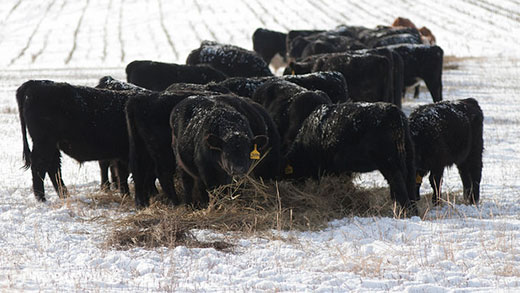Extension specialists share tips for managing cattle in winter
Reducing animal stress during cold periods is key goal.
December 29, 2017

Livestock producers are entering a time of year that can often be challenging for maintaining herd health because of winter weather, but a host of management steps and best practices can help get the animals through the tough time.
“Talking to a regional climatologist, we foresee a lot of fluctuation in weather,” said A.J. Tarpoff, a beef veterinarian with Kansas State University Research & Extension. “The fluctuations from warm to cold are stressful on any animal, so you have to be ready for that fluctuation.
“If it gets cold and it stays cold, we can manage that very easily; the animals get used to the cold, dry environment. But when we start mixing warm to cold and a little bit of moisture — in other words, we combine wind, cold and a wet animal — that leads to a little bit of trouble,” Tarpoff added.
Livestock that can be housed indoors — such as chickens, swine and dairy cattle — may be protected from severe elements, but keeping them properly ventilated can be challenging.
“It's hard to keep the fans and the ventilation adjusted appropriately, because the incoming air is still somewhat warmer during the day, but then it cools off during the night as we get the different weather fronts coming through,”, K-State Research & Extension livestock specialist Joel DeRouchey said.
DeRouchey noted that fluctuations in indoor temperatures can cause mortalities in herds because the animals get stressed from the rollercoaster shifts.
He said just like if people are going through stress, changes in the outside temperature will lead to development of respiratory challenges. “It's the same for livestock, whether they're inside or outside,” he said.
“The most important thing is maintaining a constant temperature," he explained. "The goal is to bring animals inside to protect them from the elements, so we need to make sure our ventilation systems are managed correctly to provide that ideal environment.”
DeRouchey said indoor ventilation also is important to keep air moisture, odor and nitrogen levels low.
For animals kept outside in feedlots, Tarpoff said one key is to provide dry bedding.
“Cattle have the right winter coat for cold weather, but whenever it starts to get windy, wet and cold, especially on frozen ground, the cattle want to find a nice, dry area to lie down and rest,” he said. “Bedding those pens -- giving them the opportunity to lie down and rest -- decreases the stress on those cattle and allows them to increase their comfort level so they can perform at a high rate, even in stressful conditions.”
Tarpoff added that a box scraper is an important part of the equation in feedlots. Pens should be scraped routinely to level frozen areas, which will help reduce foot injuries and the animals' reluctance to move to feed and water.
In outdoor pastures, the two specialists suggested portable windbreaks, which provide shelter and can help with basic biosecurity.
“When cattle congregate in one area of the pasture for a long period of time, you build up environmental contaminates from manure,” Tarpoff said. “So, move the portable windbreaks to different locations in the pasture so that you decrease the environmental contamination, which is especially important for newborn calves and control of scours.”
DeRouchey noted that portable windbreaks can force cattle to walk out of low areas to water and feed.
“It doesn't hurt those cows to walk out of those low areas,” he said. “From an environmental standpoint, once we start providing a lot of feed or stationary feeders in those low areas, the manure buildup and the sanitation degrades really fast.”
During severe cold periods, producers need to feed a little more hay or other forage so the animals' natural heat source — the rumen — can do its work. Cattle may be fed near windbreaks during times of extreme cold and snow, but DeRouchey said shouldn't happen very often during the season.
Tarpoff added that water for livestock is equally important in the winter months as it is in the summer months.
“They are eating a lot more, so they need to be able to drink a lot more to balance the body's homeostasis,” he explained. “Check waterers regularly (to make sure) that they are not frozen over, there's plenty of flow and there's plenty of volume for animals to drink from. A frozen tank can be detrimental to any livestock operation.”
DeRouchey and Tarpoff also shared some ideas to help producers get themselves through the colder months. Specific to the upcoming calving season, one tip is to feed cattle in the evenings.
“Changing our feeding strategies to the evening hours, right at dusk, will increase the number of calves born during the daylight hours, which is when producers are out checking those cattle more regularly,” Tarpoff said.
DeRouchey also reminded producers to make sure flashlights are in working order and to store extra batteries and clothing in case they get stranded or need to be out in cold and snowy weather for extended periods.
For more severe weather tips, producers may contact their local extension agent, the university suggested.
You May Also Like

.png?width=300&auto=webp&quality=80&disable=upscale)

